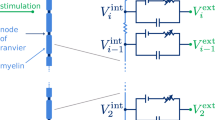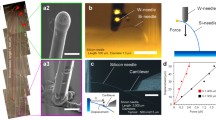Abstract
Microneurography and the use of selective microelectrodes that can resolve single-unit nerve activity have become a tool to understand the coding within the nervous system and a clinical diagnostic tool to assess peripheral neural pathologies. Central to these techniques is the use of the differences in the shape of the extracellular action potential (AP) waveform to identify and discriminate units from one another. Theoretical modeling of the origins of these shape differences has shown that the position of the nerve fiber relative to the electrode and the conduction velocity of the unit contribute to these differences giving rise to the hypothesis that more information about the fiber and its relationship to the electrode could be extracted given further analysis of the AP waveform. This paper addresses this question by exploring the electrical coupling between the electrode and nerve fiber. Idealized models and the literature indicate that two parameters, the electrode–fiber distance and the unit conduction velocity, contribute to the amplitude of the extracellular AP detected by the electrode, which confounds the quantification of coupling using the spike amplitude alone. To resolve this, we develop a method that enables differential quantification of these two parameters using spectral analysis of the single-unit AP waveform and demonstrate that the two parameters could be effectively decoupled in an in vitro earthworm model. The method could open the way forward toward micro-scale in situ monitoring of the interaction of nerve fiber and neural interface.






Similar content being viewed by others
Abbreviations
- ANOVA:
-
Analysis of variance
- AP:
-
Action potential
- ENG:
-
Electroneurogram
- FFT:
-
Fast Fourier transform
- LGF:
-
Lateral giant fiber
- MGF:
-
Medial giant fiber
- PSD:
-
Power spectral density
- RMS:
-
Root-mean-square
- StTA:
-
Stimulus-triggered average
- SEM:
-
Standard error of the mean
- SD:
-
Standard deviation
- SNR:
-
Signal-to-noise ratio
- VNC:
-
Ventral nerve cord
References
Badia J, Boretius T, Udina E, Stieglitz T, Navarro X (2011) Biocompatibility of chronically implanted transverse intrafascicular multichannel electrode (TIME) in the rat sciatic nerve. IEEE Trans Biomed Eng 8:2324–2332
Bullock TH (1945) Functional organization of the giant fiber system of Lumbricus. J Neurophysiol 8:55–71
Calancie BM, Stein RB (1988) Microneurography for the recording and selective stimulation of afferents: an assessment. Muscle Nerve 11:638–644
Cham JG, Branchaud EA, Nenadic Z, Greger B, Andersen RA, Burdick JW (2005) Semi-chronic motorized microdrive and control algorithm for autonomously isolating and maintaining optimal extracellular action potentials. J Neurophysiol 93:570–579
Dickey AS, Suminski A, Amit Y, Hatsopoulos NG (2009) Single-unit stability using chronically implanted multielectrode arrays. J Neurophysiol 102:1331–1339
Drake KL, Wise KD, Farraye J, Anderson DJ, BeMent SL (1988) Performance of planar multisite microprobes in recording extracellular single-unit intracortical activity. IEEE Trans Biomed Eng 35:719–732
Drewes CD, Landa KB, McFall JL (1978) Giant nerve fibre activity in intact, freely moving earthworms. J Exp Biol 72:217–227
Ganapathy N, Clark JW Jr (1987) Extracellular currents and potentials of the active myelinated nerve fiber. Biophys J 52:749–761
Ganguly K, Carmena JM (2009) Emergence of a stable cortical map for neuroprosthetic control. PLoS Biol 7:e1000153
Gold C, Henze DA, Koch C, Buzsaki G (2006) On the origin of the extracellular action potential waveform: a modeling study. J Neurophysiol 95:3113–3128
Gross RE, Krack P, Rodriguez-Oroz MC, Rezai AR, Benabid AL (2006) Electrophysiological mapping for the implantation of deep brain stimulators for Parkinson’s disease and tremor. Mov Disord 21(Suppl 14):S259–S283
Hoffer JA, Loeb GE, Pratt CA (1981) Single unit conduction velocities from averaged nerve cuff electrode records in freely moving cats. J Neurosci Methods 4:211–225
Jackson A, Fetz EE (2007) Compact movable microwire array for long-term chronic unit recording in cerebral cortex of primates. J Neurophysiol 98:3109–3118
Kipke DR, Shain W, Buzsaki G, Fetz E, Henderson JM, Hetke JF, Schalk G (2008) Advanced neurotechnologies for chronic neural interfaces: new horizons and clinical opportunities. J Neurosci 28:11830–11838
Lagarias JC, Reeds JA, Wright MH, Wright PE (1998) Convergence properties of the Nelder–Mead simplex method in low dimensions. SIAM J Optim 9:112–147
Lago N, Yoshida K, Koch KP, Navarro X (2007) Assessment of biocompatibility of chronically implanted polyimide and platinum intrafascicular electrodes. IEEE Trans Biomed Eng 54:281–290
Lawrence SM, Larsen JO, Horch KW, Riso R, Sinkjaer T (2002) Long-term biocompatibility of implanted polymer-based intrafascicular electrodes. J Biomed Mater Res 63:501–506
Lefurge T, Goodall E, Horch K, Stensaas L, Schoenberg A (1991) Chronically implanted intrafascicular recording electrodes. Ann Biomed Eng 19:197–207
Lujan JL, Noecker AM, Butson CR, Cooper SE, Walter BL, Vitek JL, McIntyre CC (2009) Automated 3-dimensional brain atlas fitting to microelectrode recordings from deep brain stimulation surgeries. Stereotact Funct Neurosurg 87:229–240
Malmstrom JA, McNaughton TG, Horch KW (1998) Recording properties and biocompatibility of chronically implanted polymer-based intrafascicular electrodes. Ann Biomed Eng 26:1055–1064
Marmarelis PZ, Naka K (1972) White-noise analysis of a neuron chain: an application of the Wiener theory. Science 175:1276–1278
Mulloney B (1970) Structure of the giant fibers of earthworms. Science 168:994–996
Nelder JA, Mead R (1965) A simplex method for function minimization. Comput J 7:308–313
Nicolelis MA, Dimitrov D, Carmena JM, Crist R, Lehew G, Kralik JD, Wise SP (2003) Chronic, multisite, multielectrode recordings in macaque monkeys. Proc Natl Acad Sci USA 100:11041–11046
Plonsey R (1974) The active fiber in a volume conductor. IEEE Trans Biomed Eng 21:371–381
Qiao S, Yoshida K (2012) Influence of unit distance and conduction velocity on the spectra of extracellular action potentials recorded with intrafascicular electrodes. Med Eng Phys. doi:10.1016/j.medengphy.2012.04.008
Rousche PJ, Normann RA (1998) Chronic recording capability of the Utah Intracortical Electrode Array in cat sensory cortex. J Neurosci Methods 82:1–15
Schoonhoven R, Stegeman DF (1991) Models and analysis of compound nerve action potentials. Crit Rev Biomed Eng 19:47–111
Schoonhoven R, Stegeman DF, de Weerd JP (1986) The forward problem in electroneurography. I: a generalized volume conductor model. IEEE Trans Biomed Eng 33:327–334
Schwartz AB, Cui XT, Weber DJ, Moran DW (2006) Brain-controlled interfaces: movement restoration with neural prosthetics. Neuron 52:205–220
Stegeman DF, de Weerd JP, Eijkman EG (1979) A volume conductor study of compound action potentials of nerves in situ: the forward problem. Biol Cybern 33:97–111
Stein RB, Pearson KG (1971) Predicted amplitude and form of action potentials recorded from unmyelinated nerve fibres. J Theor Biol 32:539–558
Stephanova D, Trayanova N, Gydikov A, Kossev A (1989) Extracellular potentials of a single myelinated nerve fiber in an unbounded volume conductor. Biol Cybern 61:205–210
Struijk JJ (1997) The extracellular potential of a myelinated nerve fiber in an unbounded medium and in nerve cuff models. Biophys J 72:2457–2469
Struijk LN, Akay M, Struijk JJ (2008) The single nerve fiber action potential and the filter bank: a modeling approach. IEEE Trans Biomed Eng 55:372–375
Vetter RJ, Williams JC, Hetke JF, Nunamaker EA, Kipke DR (2004) Chronic neural recording using silicon-substrate microelectrode arrays implanted in cerebral cortex. IEEE Trans Biomed Eng 51:896–904
Vitek JL, Bakay RA, Hashimoto T, Kaneoke Y, Mewes K, Zhang JY, Rye D, Starr P, Baron M, Turner R, DeLong MR (1998) Microelectrode-guided pallidotomy: technical approach and its application in medically intractable Parkinson’s disease. J Neurosurg 88:1027–1043
Vitek JL, Delong MR, Starr PA, Hariz MI, Metman LV (2011) Intraoperative neurophysiology in DBS for dystonia. Mov Disord 26(Suppl 1):S31–S36
Welch PD (1967) The use of fast Fourier transform for the estimation of power spectra: a method based on time averaging over short, modified periodograms. IEEE Trans Audio Electroacoust 15:70–73
Wolf MT, Cham JG, Branchaud EA, Mulliken GH, Burdick JW, Andersen RA (2009) A robotic neural interface for autonomous positioning of extracellular recording electrodes. Int J Robot Res 28:1240–1256
Yoshida K, Stein RB (1999) Characterization of signals and noise rejection with bipolar longitudinal intrafascicular electrodes. IEEE Trans Biomed Eng 46:226–234
Yoshida K, Struijk JJ (2004) The theory of peripheral nerve recording. In: Horch KW, Dhillon GS (eds) Neuroprosthetics: theory and practice. World Scientific Publishing Co Pte Ltd, Singapore, pp 342–428
Yoshida K, Kurstjens GA, Hennings K (2009) Experimental validation of the nerve conduction velocity selective recording technique using a multi-contact cuff electrode. Med Eng Phys 31:1261–1270
Yoshida K, Farina D, Akay M, Jensen W (2010) Multichannel intraneural and intramuscular techniques for multiunit recording and use in active prostheses. Proc IEEE 98:432–449
Acknowledgments
This work was supported by the BME Department Faculty Development Fund at Indiana University-Purdue University Indianapolis.
Author information
Authors and Affiliations
Corresponding author
Rights and permissions
About this article
Cite this article
Qiao, S., Odoemene, O. & Yoshida, K. Determination of electrode to nerve fiber distance and nerve conduction velocity through spectral analysis of the extracellular action potentials recorded from earthworm giant fibers. Med Biol Eng Comput 50, 867–875 (2012). https://doi.org/10.1007/s11517-012-0930-8
Received:
Accepted:
Published:
Issue Date:
DOI: https://doi.org/10.1007/s11517-012-0930-8




